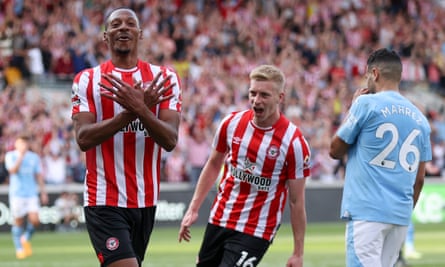City against a front two
Inter’s deployment of a front two is not an unknown issue for Manchester City to combat but it is an unfamiliar one. Lautaro Martínez has spells when he cannot score – as happened in the World Cup – but when he is hot he is hot, and he has scored 11 times in his past 13 games. He will probably be partnered by Edin Dzeko, now 37 but still an effective, intelligent and underrated target man. Romelu Lukaku then offers an unpredictable element from the bench.
Modern centre-backs face a front two only rarely. Against a single striker, one central defender can mark and one drop off as cover; when both have to mark the challenge is different. City faced a front two on eight occasions in the league this season, winning five, drawing one and losing two. It’s a small sample size, but it is at the very least intriguing that City kept just two clean sheets in those games (25%), as opposed to 11 in the 30 (36.7%) against sides playing a single striker.
On a more practical level, playing against two central forwards makes it a bigger risk for John Stones to step up from centre-back into midfield. In only one of those eight games did Stones play in his hybrid role, but that was against Southampton in a match City won 4-1 (and in which Kyle Walker replaced him 11 minutes after half-time), which makes it extremely difficult to know how Guardiola may address the challenge. There were 12 minutes plus injury time of Wout Weghorst alongside Marcus Rashford in the Cup final, but the shape of the game and the fact City were protecting a lead means that isn’t much of a guide either. It could be that Stones starts at full-back and goes into midfield from there, assuming Federico Dimarco doesn’t get too far forward from wing-back. Or it may be that Stones simply operates as a more orthodox central defender.
City against a back three
Back threes are far more common than front twos these days; City have come up against them 13 times in the league this season. Those games have yielded 2.15 points per game, appreciably less than the 2.44 points per game City picked up in their other 25 games, which may be because the best way to thwart Haaland is to get players around him. That theory seems to be contradicted by the fact that Haaland has scored 11 goals from open play in those 13 games, but seven of them (plus a penalty) came in the first four, against Bournemouth, Crystal Palace, Nottingham Forest and Brighton; he has four in the nine games since.
There is another intriguing detail here, albeit one that must be caveated by pointing out the extremely low sample size, and that is that City have played four times against teams who play a 5-3-2 similar to Inter’s (acknowledging that the difference between 5-3-2 and 3-4-1-2 isoften minimal or in the eye of the beholder). City beat Forest 6-0, but have also drawn against Frank Lampard’s Everton (albeit slightly freakishly) and twice lost to Brentford (albeit once with a weakened team on the final day of the season).
Can Inter get their 5-3-2 operating like Brentford’s? There is a clear problem up front. Where Brentford could use a very mobile front two in Bryan Mbeumo and either Ivan Toney or Yoane Wissa, Inter are more restricted: neither Dzeko nor Lukaku offers that sort of dynamism.
But perhaps the bigger lesson from Brentford is that a team sitting deep can frustrate City so long as Haaland doesn’t dominate in the air, so long as space isn’t offered behind the full-backs (which is how Real Madrid were undone as Bernardo Silva got the better of Eduardo Camavinga) and so long as at least some threat is offered on the break.
after newsletter promotion
Inter’s wing-backs and the Brentford Protocol
It says something about the modern financial landscape that it makes sense to tell one of the sides in the Champions League final that they need to be more like Brentford, but it’s true. Brentford’s win at the Etihad in November was the most convincing display any side put in against City all season – although admittedly before the Stones reinvention. The key was the pace at which they were able to break – always a potential way of getting at any Pep Guardiola side – not only through the front two but also through Rico Henry, the left wing-back, who forced Silva to track back by driving forward when Brentford won the ball. Dimarco managed four goals and three assists in the league last season and Denzel Dumfries one goal and four assists. Both wing-backs are clearly capable of getting forward but whether they can do that and shut down City’s flanks is another matter.

The centre
Given the probability is that Inter will sit deep, with a back five to combat City’s three forwards, that probably means a deep three-man block in midfield of Nicolò Barella, Marcelo Brozovic and Hakan Calhanoglu. Their job will largely be to clog up the area and prevent Kevin De Bruyne or Ilkay Gündogan having time or space, with Stones potentially adding a fourth central body to complicate the issue. But Inter are fortunate that all three are capable passers who may be able to spring a counter, either using the width offered by the wing-backs or going direct to Dzeko and Martínez. City, almost certainly, will have the middle of the pitch to themselves.

